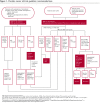Guideline for referral of patients with suspected prostate cancer by family physicians and other primary care providers
- PMID: 25756141
- PMCID: PMC4301761
Guideline for referral of patients with suspected prostate cancer by family physicians and other primary care providers
Abstract
Objective: The aim of this guideline is to assist FPs and other primary care providers with recognizing features that should raise their suspicion about the presence of prostate cancer in their patients.
Composition of the committee: Committee members were selected from among the regional primary care leads from the Cancer Care Ontario Provincial Primary Care and Cancer Network and from among the members of the Cancer Care Ontario Genitourinary Cancer Disease Site Group.
Methods: This guideline was developed through systematic review of the evidence base, synthesis of the evidence, and formal external review involving Canadian stakeholders to validate the relevance of recommendations.
Report: Evidence-based guidelines were developed to improve the management of patients presenting with clinical features of prostate cancer within the Canadian context.
Conclusion: These guidelines might lead to more timely and appropriate referrals and might also be of value for informing the development of prostate cancer diagnostic programs and for helping policy makers to ensure appropriate resources are in place.
Objectif: Ces lignes directrices ont pour but d’aider les médecins de famille et les autres professionnels des soins primaires à reconnaître les caractéristiques qui devraient les faire soupçonner la présence d’un cancer de la prostate chez leurs patients.
Composition du comité: Les membres du comité ont été choisis parmi les directeurs des soins primaires régionaux du Réseau provincial des soins primaires et de la lutte contre le cancer d’Action Cancer Ontario et les membres du Groupe sur le siège de la maladie - Cancers génito-urinaires d’Action Cancer Ontario.
Méthode: L’élaboration de ces lignes directrices est fondée sur une recension systématique des données probantes, une synthèse des données scientifiques et un examen externe formel impliquant des intervenants canadiens pour valider la pertinence des recommandations.
Rapport: Des lignes directrices fondées sur des données probantes ont été élaborées pour améliorer la prise en charge des patients présentant des caractéristiques cliniques de cancer de la prostate, et ce, dans le contexte canadien.
Conclusion: Ces lignes directrices pourraient entraîner des demandes de consultation plus appropriées et en temps plus opportuns. Elles pourraient aussi être utiles pour éclairer l’élaboration de programmes de diagnostic du cancer de la prostate et aider les décideurs à assurer la mise en place des ressources nécessaires.
Figures

Similar articles
-
Guideline for referral of patients with suspected lung cancer by family physicians and other primary care providers.Can Fam Physician. 2014 Aug;60(8):711-6, e376-82. Can Fam Physician. 2014. PMID: 25122814 Free PMC article.
-
Guideline for referral of patients with suspected colorectal cancer by family physicians and other primary care providers.Can Fam Physician. 2014 Aug;60(8):717-23, e383-90. Can Fam Physician. 2014. PMID: 25122815 Free PMC article.
-
Digital rectal examination in primary care is important for early detection of prostate cancer: a retrospective cohort analysis study.Br J Gen Pract. 2014 Dec;64(629):e783-7. doi: 10.3399/bjgp14X682861. Br J Gen Pract. 2014. PMID: 25452543 Free PMC article.
-
[The general practitioner's part in the initiation of diagnostic procedures in prostate cancer].Aktuelle Urol. 2008 Mar;39(2):141-6. doi: 10.1055/s-2007-993037. Aktuelle Urol. 2008. PMID: 18379968 German.
-
Are primary care providers implementing evidence-based care for breast cancer survivors?Can Fam Physician. 2015 Nov;61(11):978-84. Can Fam Physician. 2015. PMID: 26889509 Free PMC article.
Cited by
-
Screening for prostate cancer: protocol for updating multiple systematic reviews to inform a Canadian Task Force on Preventive Health Care guideline update.Syst Rev. 2022 Oct 26;11(1):230. doi: 10.1186/s13643-022-02099-9. Syst Rev. 2022. PMID: 36289518 Free PMC article.
-
Overview on Patient Centricity in Cancer Care.Front Pharmacol. 2017 Oct 5;8:698. doi: 10.3389/fphar.2017.00698. eCollection 2017. Front Pharmacol. 2017. PMID: 29051734 Free PMC article.
-
A Novel Combination of Serum Markers in a Multivariate Model to Help Triage Patients Into "Low-" and "High-Risk" Categories for Prostate Cancer.Front Oncol. 2022 May 19;12:837127. doi: 10.3389/fonc.2022.837127. eCollection 2022. Front Oncol. 2022. PMID: 35664747 Free PMC article.
-
Systematic review of clinical features of suspected prostate cancer in primary care.Can Fam Physician. 2015 Jan;61(1):e26-35. Can Fam Physician. 2015. PMID: 25756146 Free PMC article.
References
-
- What is cancer? Toronto, ON: Canadian Cancer Society; 2011. Cancer.ca [website] Available from: www.cancer.ca/Canada-wide/About%20cancer/Cancer%20statistics.aspc?sc_lan.... Accessed 2011 Dec 2.
-
- Canadian Partnership Against Cancer, Screening Action Group. PSA toolkit: PSA screening and testing for prostate cancer. Toronto, ON: Canadian Partnership Against Cancer; 2009. Available from: www.cancerview.ca/idc/groups/public/documents/webcontent/screen_panel_ps.... Accessed 2011 Feb 8.
-
- Browman GP, Levine MN, Mohide EA, Hayward RS, Pritchard KI, Gafni A, et al. The practice guidelines development cycle: a conceptual tool for practice guidelines development and implementation. J Clin Oncol. 1995;13(2):502–12. - PubMed
-
- New Zealand Guidelines Group. Suspected cancer in primary care: guidelines for investigation, referral and reducing ethnic disparities. Wellington, NZ: New Zealand Guidelines Group; 2009.
Publication types
MeSH terms
Substances
LinkOut - more resources
Full Text Sources
Other Literature Sources
Medical
Research Materials
Miscellaneous
